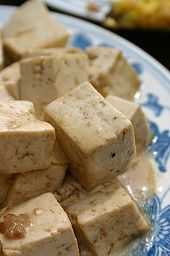High-protein diet

A high-protein diet is often recommended by bodybuilders and nutritionists to help efforts to build muscle and lose fat. It should not be confused with low-carb diets such as the Atkins Diet, which are not calorie-controlled and which often contain large amounts of fat.
While adequate protein is required for building skeletal muscle and other tissues, there is ongoing debate regarding the use and necessity of high-protein diets in anaerobic exercise in particular weight training and bodybuilding.
Health effects
Extreme protein intake (in excess of 200 g per day), coupled with inadequate intake of other calorie sources (fat or carbohydrates), can cause a form of metabolic disturbance and death commonly known as rabbit starvation.[1]
Relatively little evidence has been gathered regarding the effect of long-term high intake of protein on the development of chronic diseases.[2] Increased load on the kidney is a result of an increase in reabsorption of NaCl. This causes a decrease in the sensitivity of tubuloglomerular feedback, which, in turn, results in an increased glomerular filtration rate. This increases pressure in glomerular capillaries.[3] When added to any additional renal disease, this may cause permanent glomerular damage.
As is apparent from the list below, many high-protein foods (indeed, most low-carb foods with protein) are fairly low in fiber. This can lead to discomfort if additional roughage is not added to the diet.
High-protein foods
High-protein foods include:
| Food | Amount of protein |
|---|---|
| Soy protein isolate | 80 g per 100 g[4] |
| Boiled green soybeans | 12 g per 100 g[lower-alpha 1][5] |
| Whey protein concentrate | up to 89 g per 100 g (Average, varies between brands)[6] |
| Whey protein isolate | 90+ g per 100 g (Average, varies between brands)[6] |
| Peanuts | 24 g per 100 g[lower-alpha 2][5] |
| Steak | 27 to 34 g per 100 g[lower-alpha 3][5] |
| Chicken breast | 31 g per 100 g[lower-alpha 4][5] |
| Salmon fillet | 25 g per 100 g[lower-alpha 5][5] |
| Tuna, canned | 19 g per 100 g[lower-alpha 6][5] |
Protein and weight training

Protein is described as essential by advocates of the high-protein diet, which includes a large proportion of the bodybuilding community; it is claimed to provide the muscle with amino acids required to repair the damage done by anaerobic exercise. Some consume Protein supplements after bodybuilding workouts, as they provide a quick and easily consumable protein source. Alternatively, meat, beans, or other high-protein foods are consumed.
It is possible to maintain a strict vegan high-protein diet, though due to the lower nutrient density of plant-based foods this requires a larger absolute volume of food compared to a non-vegan diet; simply put, vegans must consume a lot more food to get a lot of protein.[7]
Although some testing shows that the body will absorb and use a greater amount of protein after "bodybuilding" type exercises than under more sedentary circumstances,[8] and some studies on weight training show clinically significant gains in muscle with a very high protein diet when compared to more moderate intake, in some studies increased protein intake fails to translate into functional differences in strength or muscle size.[9] However, consistently consuming less protein than an individual's body requires (approximately 0.7g/kg/day for a sedentary individual)[10] causes loss of existing lean body mass, even with an excessively caloric diet.[11]
See also
| Wikibooks Cookbook has a recipe/module on |
Notes
References
- ↑ Bilsborough, Shane; Mann, Niel (April 2006). "A review of issues of dietary protein intake in humans". International Journal of Sport Nutrition and Exercise Metabolism 16 (2). PMID 16779921. Retrieved 8 August 2013.
- ↑ "Protein: Moving Closer to Center Stage". Harvard School of Public Health. Retrieved 8 August 2013.
- ↑ Walter F., PhD. Boron. Medical Physiology: A Cellular And Molecular Approach. Elsevier/Saunders. p. 771. ISBN 1-4160-2328-3.
- ↑ "USDA National Nutrient Database for Standard Reference Release 25: Nutrient data for 16122, Soy protein isolate". United States Department of Agriculture. Retrieved 8 August 2013.
- ↑ 5.0 5.1 5.2 5.3 5.4 5.5 "USDA National Nutrient Database for Standard Reference, Release 25: Protein ( g ) Content of Selected Foods per Common Measure, sorted alphabetically". United States Department of Agriculture. 2012. Retrieved 8 August 2013.
- ↑ 6.0 6.1 "Everything you want to know about Whey Protein Isolate but were afraid to ask". Best of Whey Protein. Retrieved 13 June 2011.
- ↑ Pilon, Mary (4 January 2012). "Sculptured by Weights and a Strict Vegan Diet". The New York Times. Retrieved 9 August 2013.
- ↑ Lemon, P. W. R.; Tarnopolsky, M. A.; MacDougall, J. D.; Atkinson, S. A. (August 1992). "Protein requirements and muscle mass/strength changes during intensive training in novice bodybuilders". Journal of Applied Physiology 73 (2). PMID 1400008. Retrieved 9 August 2013.
- ↑ Tipton, K. D.; Wolfe, R. R. (2004). "Protein and amino acids for athletes". Journal of Sports Sciences 22 (1). doi:10.1080/0264041031000140554. PMID 14971434. Retrieved 9 August 2013.
- ↑ "Dietary Reference Intakes (DRIs): Estimated Average Requirements". Food and Nutrition Board, Institute of Medicine. Retrieved 9 August 2013.
- ↑ Bray, George A.; et al. (January 2012). "Effect of Dietary Protein Content on Weight Gain, Energy Expenditure, and Body Composition During Overeating: A Randomized Controlled Trial". Journal of the American Medical Association 307 (1). doi:10.1001/jama.2011.1918. PMID 22215165. Retrieved 9 August 2013.